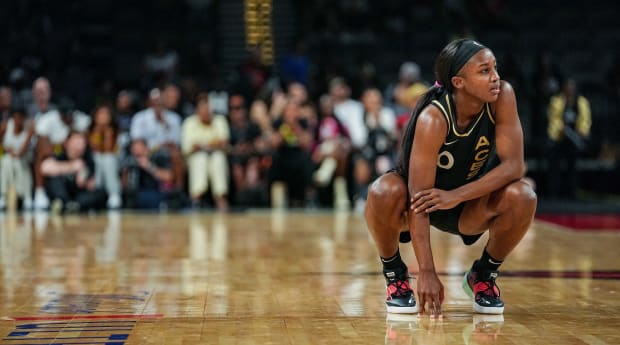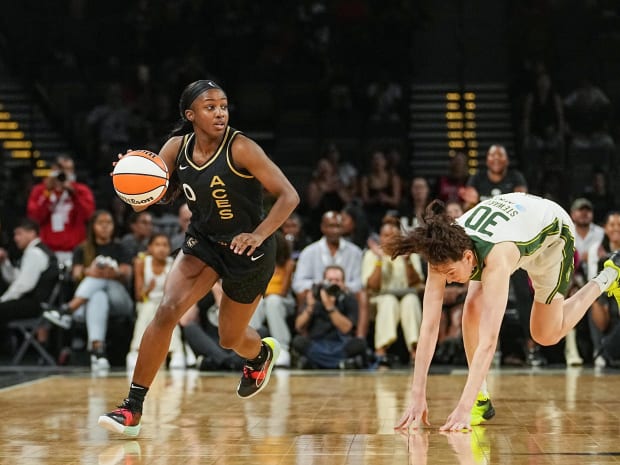Equipped with a recently developed on-court confidence, the former No. 1 pick has become a threat at the three-point line.
On the day before this summer’s WNBA All-Star Game, Jackie Young found a seat at a dais and for four minutes didn’t say anything. Positioned to her left were guards Skylar Diggins-Smith and Arike Ogunbowale, the trio grouped together for a joint press conference with reporters across the street from Chicago’s Wintrust Arena. As journalists started to ask questions, Young didn’t speak up.
“You gotta say a word, Jackie, up here,” Mercury guard Diggins-Smith said to Young, who had let the first three queries pass her by. “You gotta say something.”
Young, 24, admits she is shy by nature. Even ahead of what was one of the biggest moments of her four-year professional career so far, the Aces guard didn’t publicly savor being named an All-Star starter. Rather, those who know Young best cite a quiet confidence. “She very much carries herself like the star that she is and will continue to be,” Las Vegas assistant coach Tyler Marsh says.

Erick W. Rasco/Sports Illustrated
The Aces enter the WNBA postseason as the No. 1 seed, set to open their playoff run against the Mercury on Wednesday. The team features perhaps the most dangerous core in the league. A’ja Wilson, 2020’s Most Valuable Player, is among the favorites to claim the aforementioned honor, and guard Kelsey Plum, who like Young was named a first-time All-Star in July, has been one of the W’s top players this summer, too. Plum’s backcourt partner, Chelsea Gray, a U.S. Olympian in Tokyo, remains both steady and forceful, and, when healthy two-time All-Star forward Dearica Hamby—she is expected to be out two to four weeks with a right knee contusion—presents matchup problems on both ends of the floor.
Then there is Young, who like Wilson and Plum was a No. 1 draft pick. In previous seasons she has struggled being fully comfortable on the court. But now in her fourth year, previous oscillations have seldom resurfaced. Equipped with a recently developed confidence from behind the three-point arc, an unlocked Young—a favorite for the league’s Most Improved Player Award—could be the piece that pushes the Aces to their first WNBA title. “She’s not going to be the loudest in the room,” Plum says. “But you’re gonna feel her presence.”
Growing up in Princeton, Ind., Young says she always loved eating school lunch. Not because of its indelible flavors, but because of its dependability—she knew it would be served daily. Raised by a single mother, Linda, Young says her family “struggled [financially] my whole life,” at times having to deal with lights being turned off in their home and wondering about what future meals would consist of. It’s why at school she says she shoveled in as much chicken Alfredo or tacos as she could, because at home “we didn’t know how much we were gonna get.”
Amid such uncertainty, Young says basketball provided her with a “way out.” Reaching the WNBA became an early aspiration because of her interest in the sport and the financial benefits it could provide those around her.
Long before she played in the entertainment capital of the world, she practiced her ballhandling on a backyard grass plot. In part due to her battles with her older brother, Terrence, every year their makeshift court “pretty much turned to dirt,” she says, “because of so much playing out there.”
In her earliest organized basketball experience, Young merely tried to fit in; she was 5 and participating in a coed Salvation Army league, having lied about her age on the sign-up sheet because of her strong desire to compete. “I just wanted to do what [my brother] did,” she says. But as Young grew older, she made her own mark on the court. Following her senior year of high school, she was named Indiana’s Miss Basketball, a McDonald’s All-American and the Naismith National High School Player of the Year. Plus, at the time of her high school graduation, she was the leading scorer among all genders in Hoosier State history.
In classroom settings, though, Young remained humble and unassuming. She says she was the kind of student who knew the answer to questions but didn’t raise her hand. Countless times, she recalls thinking to herself, Oh, yeah. I knew that, once a correct response was shared aloud. Such a tendency is why even today, when Young is on the WNBA hardwood, Aces coach Becky Hammon pushes her to speak up. “If you know the answer, say it,” Young says Hammon often tells her. “Help the team, and tell them what you see.”
After three seasons at Notre Dame, Young declared for the 2019 WNBA draft. Unlike some contemporaries in her rookie class who knew their next step all year, Young made her decision to leave college rather abruptly, doing so in the 24 hours after the Fighting Irish lost the national championship game to Baylor. “I knew that if I could help my family a year earlier, then that is what I was gonna do,” she says.
While as a child she dreamed of being picked first, she quickly felt the external pressures that came with such a billing. Throughout her debut season, primarily playing point guard, she started all 34 games for Las Vegas. Her 4.5 assists per game—still a career high—were a sign of her unselfishness, but she averaged only 6.6 points and shot merely 32.2% from the field.
“It’s the curse of the No. 1 pick,” says Plum, the top selection in the 2017 draft. “Everyone wants to kill you, and you don’t know why.”
Over the course of the following two seasons, Young showed steady improvement, even without a firm role. During the 2020 bubble season, then coach Bill Laimbeer brought Young off the bench. Last year, in what turned out to be Laimbeer’s final with the team, she returned to the starting lineup and played mostly off-ball on offense, largely as a result of Gray’s decision to join the franchise in free agency.
Shortly after taking the Aces’ coaching job in January, Hammon called Young to explain how she planned to use her. The main directive from Hammon was to have a willingness to shoot more threes. Young had taken just 33 in her past two seasons combined, 11 short of her attempt total from her rookie campaign. Under Hammon, the Aces’ offense would now rely on stretching the floor.
“Honestly, I think it was a mental thing,” Young says of why she seldom took them. “But I definitely bought into [Hammon], trusted her and knew what I needed to do.”
The groundwork that helped Young develop into a three-point threat was laid in Australia. She played for the WNBL’s Perth Lynx this past winter alongside Marina Mabrey, a former teammate at Notre Dame and a guard on the WNBA’s Wings. Young was open with Mabrey about wanting to improve from the perimeter, and Mabrey, being a fearless shooter, had a plan to help her teammate do just that.
The two made a deal. “We kinda agreed she would help me in the weight room, and I would help her shoot and stuff,” Mabrey says. In late January, even as Mabrey nursed a foot injury, she supervised Young during workouts, often twice daily. They consisted of about 500 shots per day—a mix of jumpers from deep and the midrange. Once Mabrey returned to action, that number eventually grew to 1,500 per player, per day, with Mabrey providing Young constant reminders about specific moves and the importance of remaining aggressive.
“Jackie’s one of those people; she wants to be efficient, she wants to always be helping the team, and that’s great,” Mabrey says. “But helping the team also means being confident no matter if the ball’s going in or not.”

Erick W. Rasco/Sports Illustrated
Marsh, the Aces’ assistant coach, joined the staff aware of Young’s athletic frame, aggression and physicality. But he, too, saw an opportunity for her to develop from long range. Once Young returned from Australia, the two tweaked her mechanics, trying to create a more fluid motion in her shot. Marsh says the changes entailed keeping the ball more on her right side and not in front of her face, maintaining better balance and finding footwork that felt comfortable, no matter what direction she was moving in. Early on, both in practice and in game play, Young saw her work pay immediate dividends.
While she didn’t attempt a three in the season opener vs. the Mercury, she made multiple threes in three of the following five games. “I think that really gave her momentum to keep up what we had been working on and what she had been working on,” Marsh says. And after attempting just more than 30 threes last season, she made at least two shots from deep in 14 games this year.
Wilson believes the fact opponents wouldn’t previously guard Young from the outside “boiled inside her.” But no longer can foes sag off Young and exclusively double Wilson. Instead, they are often forced to run Young off the three-point line and push her inside the arc, where she has always been prolific.
“When it came to threes, for some reason there was just like a mental block there, and I think it was just getting over that and trusting myself,” she says.
And because of that self-belief, Young’s game has opened up. While continuing to guard the opposing team’s best perimeter player, she is averaging career highs in points (15.9), rebounds (4.4), and three-point attempts (3.4 per game), while also shooting 43.1% from deep.
Even as she’s unlocked her personal game, she has remained focused on the teamwide goal of a title. “I’m at my best when I have a good mindset,” Young says. Heading into the postseason, she has just that.
While there are still times she isn’t as bombastic as her fun-loving teammates, there’s no longer an unassertiveness about her. “Jackie’s just been tremendous,” says Plum. “She’s very comfortable with who she is.”
More WNBA Coverage:
• 2022 WNBA Playoffs Picks and Predictions
• WNBA Championship Odds: Kelsey Plum Leads Aces
• The Many Faces of Sylvia Fowles
• Brittney Griner’s Off-the-Court Impact Remains in Phoenix